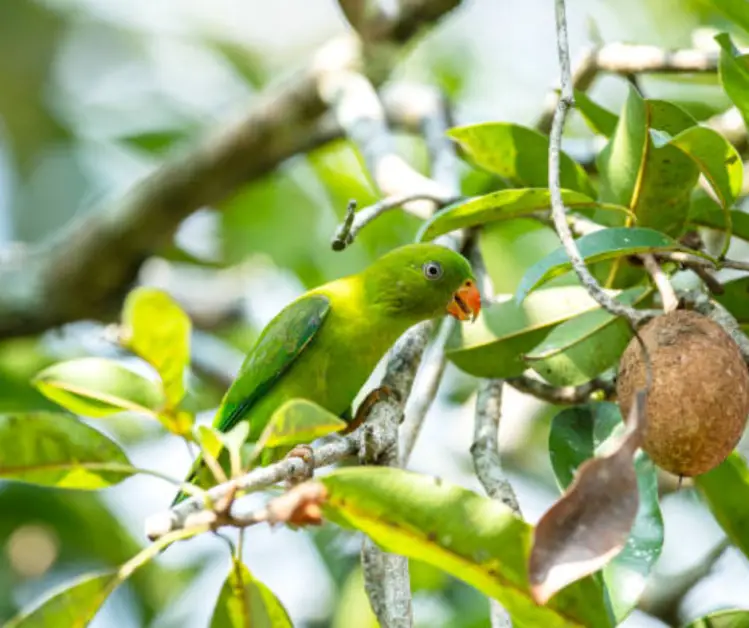Mamey Sapote: A Giant Tropical Berry Treat
Table of Contents
Overview of Mamey Sapote
Mamey Sapote, scientifically known as Pouteria sapota, is a tropical fruit that hails from the Caribbean and Central America. This delectable fruit is popular for its sweet and creamy flavor, often likened to a combination of sweet potato, banana, and pumpkin. It belongs to the Sapotaceae family and is botanically classified as a berry due to its fleshy nature and numerous seeds embedded within.
The Mamey Sapote fruit is oval or oblong in shape, about 4-12 inches long with a tough, brown skin that encases vibrant, salmon-colored to orange flesh. Its texture is creamy and smooth, with a rich taste that has hints of almond and honey. The fruit’s flavor profile makes it a versatile ingredient in both sweet and savory dishes, appealing to culinary enthusiasts and health-conscious individuals alike.

Origin and History of Mamey Sapote
Mamey Sapote, scientifically known as Pouteria sapota, is a tropical fruit native to southern Mexico and Central America. Belonging to the Sapotaceae family, this fruit has a rich historical significance dating back to the ancient Mayan and Aztec civilizations. The Mamey Sapote tree thrives in warm climates with well-drained soil, making it a staple in the diets of many indigenous communities throughout history.
Introduced to areas like the Caribbean, Florida, and other tropical regions, the cultivation of Mamey Sapote expanded, allowing more people to experience its unique flavor and numerous health benefits. With its origins deeply rooted in Mesoamerican cultures, Mamey Sapote has transcended time, becoming not only a culinary delight but also a symbol of tradition and cultural heritage.
Physical Characteristics of Mamey Sapote
Mamey Sapote, scientifically known as Pouteria sapota, is a delicious tropical fruit native to southern Mexico and Central America. The physical characteristics of Mamey Sapote include its large ovoid-shaped fruit, typically measuring 4 to 12 inches in length and weighing up to 10 pounds. The skin of the Mamey Sapote is rough and brownish, similar to that of a russet potato, while the flesh inside ranges in color from salmon pink to orange.
When ripe, the Mamey Sapote fruit yields to gentle pressure, indicating its readiness for consumption. The flesh is smooth, creamy, and fragrant, with a sweet and rich flavor reminiscent of a combination of sweet potato, pumpkin, and almond. Inside the fruit, there is a large, shiny, dark brown seed, which should be discarded before consuming the delectable flesh.
Nutritional Value of Mamey Sapote
Mamey sapote, a tropical fruit native to Central America, not only delights with its rich flavor but also offers a wealth of nutrients. This unique fruit is a good source of dietary fiber, providing about 5 grams per cup, aiding in digestion and promoting gut health. Additionally, mamey sapote is rich in vitamins and minerals, particularly vitamin C, which supports immune function, and vitamin A, essential for vision and skin health.
Moreover, mamey sapote boasts a significant potassium content, with approximately 555 milligrams per cup. Potassium is crucial for maintaining healthy blood pressure levels and proper muscle function. This fruit also contains antioxidants like beta-carotene, lutein, and zeaxanthin, which help combat oxidative stress and inflammation in the body. With its impressive array of nutrients, mamey sapote can be a valuable addition to a balanced diet, promoting overall health and well-being.
Table is shown below
| Nutrient | Amount | % Daily Value (DV) |
|---|---|---|
| Calories | 217 | – |
| Protein | 2.5 grams | – |
| Fat | 1 gram | – |
| Carbohydrates | 56 grams | – |
| Fiber | 9.5 grams | – |
| Vitamin B6 | 74% of DV | – |
| Vitamin C | 45% of DV | – |
| Copper | 41% of DV | – |
| Vitamin E | 25% of DV | – |
| Potassium | 17% of DV | – |
| Riboflavin | 16% of DV | – |
| Niacin | 16% of DV | – |
| Manganese | 16% of DV | – |
| Pantothenic acid | 14% of DV | – |
| Iron | 8% of DV | – |
Mamey Sapote is particularly rich in vitamin B6, which supports protein metabolism, brain function, and immune health. It’s also a good source of vitamin C, an antioxidant that protects against inflammation and cell damage. Additionally, the fruit provides essential minerals like copper and potassium.
Health Benefits of Consuming Mamey Sapote
Mamey sapote is not only delicious but also packed with essential nutrients that can benefit your overall well-being. This tropical fruit is a good source of dietary fiber, which aids digestion and promotes gut health. Additionally, mamey sapote is rich in vitamins A and C, powerful antioxidants that help boost your immune system and protect your cells from damage.
Moreover, mamey sapote contains minerals like potassium, magnesium, and copper, which play a vital role in maintaining healthy blood pressure, nerve function, and bone health. Including mamey sapote in your diet can be a flavorful way to enhance your nutrient intake and support your body’s daily functions.

Culinary Uses of Mamey Sapote
Mamey sapote is a versatile fruit that can be used in various culinary creations. Its sweet and creamy flesh makes it a popular ingredient in both sweet and savory dishes. From smoothies and desserts to salsas and salads, mamey sapote adds a unique flavor and texture that is sure to delight the taste buds.
One popular way to enjoy mamey sapote is by simply scooping out the flesh and eating it fresh. Its rich and custard-like consistency makes it a delicious and satisfying treat on its own. Additionally, mamey sapote can be used to make ice cream, pudding, pies, and even cocktails. Its natural sweetness makes it a great alternative to sugar in recipes, adding a healthy twist to your favorite dishes.
How to Select Ripe Mamey Sapote
When selecting a ripe Mamey Sapote, it’s crucial to pay attention to several key indicators to ensure you’re getting the best quality fruit. Firstly, examine the skin of the Mamey Sapote. A mature fruit will have a slightly rough texture and give in slightly to gentle pressure. Avoid fruits with blemishes, bruises, or soft spots, as these may indicate overripeness or internal issues that affect the taste and texture.
Next, consider the color of the fruit. A ripe Mamey Sapote will typically have a reddish-brown or russet skin color, with variations depending on the variety. Some Mamey Sapotes may also exhibit a slight fragrant aroma when ripe. Lastly, gently press the fruit near the stem – a ripe Mamey Sapote should yield slightly but not feel overly soft. By following these visual and tactile cues, you can ensure a flavorful and enjoyable Mamey Sapote eating experience.
How to Store Mamey Sapote
To store Mamey Sapote, it is essential to ensure the fruit remains fresh and retains its flavor. Mamey Sapote can be stored at room temperature until ripe, after which it should be refrigerated to prolong its shelf life. When selecting a Mamey Sapote for storage, look for fruits that yield slightly to gentle pressure.
To store a ripened Mamey Sapote, place it in the refrigerator in a plastic bag to maintain humidity and prevent dehydration. Keep the fruit away from strong-smelling foods as it can absorb odors easily. It is best to consume Mamey Sapote within a few days of ripening for the best taste and texture.
Different Varieties of Mamey Sapote
Mamey Sapote, a delectable tropical fruit, comes in various varieties, each with unique characteristics and flavor profiles. Among the different types of Mamey Sapote, the “Magana” variety is highly prized for its large fruit size and rich, creamy texture. It is known for its sweet and aromatic taste, making it a favorite among fruit enthusiasts worldwide.
Another popular type is the “Pantin” variety, which is celebrated for its vibrant reddish-brown skin and smooth, buttery flesh. The Pantin Mamey Sapote is often used in culinary creations due to its versatile nature and excellent flavor. Each Mamey Sapote variety offers a distinct experience, making it exciting for gardening enthusiasts to explore the nuances of these unique fruits.
- Black Sapote:
- Also known as chocolate pudding fruit or zapote prieto, black sapote belongs to the persimmon family.
- Appearance: Round, similar to a tomato, and grows up to 11 inches in diameter. When ripe, its skin turns from green to dark brown or almost black.
- Flesh: Resembles chocolate pudding, with a mild, sweet flavor. Perfect for desserts like ice cream, smoothies, or pies.
- Taste: Smooth flesh tastes like a mix of cocoa and caramel.
- Mamey Sapote:
- Found in Central America and the Caribbean, mamey sapotes look different from their cousins.
- Appearance: Brown, rough exterior that can be tough to peel due to its softness. Interior is soft, creamy, and bright orange (salmon) in color.
- Flavor: Sweet, often compared to sweet potatoes with hints of caramel and brown sugar.
- Uses: Enjoyed in desserts (ice creams, smoothies) or used in savory dishes (sauces, salsas). Seeds contain oils used in beauty products.
- White Sapote:
- Also known as Mexican apples or casimiroa, white sapotes hail from Central America and Mexico.
- Appearance: Yellowish-green skin, round to oval shape (diameter between 1.9-3.9 inches), creamy white flesh with 2-3 seeds inside.
- Texture: Creamy like custard or avocado.
- Flavor: A delightful blend of sweet potato, pumpkin, honey, prune, peach, apricot, cantaloupe, cherry, and almond.
Growing Conditions for Mamey Sapote Trees
Mamey Sapote trees thrive in tropical or subtropical climates with temperatures consistently above 50°F (10°C). Ideally, they require well-draining, fertile soil with a pH level between 5.0 and 7.0. These trees prefer full sun exposure for optimal growth and fruit production. In regions where frost occurs, it is important to protect young Mamey Sapote trees until they are more established to prevent damage.
For successful cultivation, regular watering is essential, especially during dry spells, as Mamey Sapote trees have a high water requirement. It is crucial to avoid waterlogged conditions to prevent root rot. Fertilizing the trees with a balanced fertilizer every 6-8 weeks during the growing season can promote healthy growth and fruit development. Pruning should be done to maintain the tree’s shape and encourage air circulation within the canopy.
Harvesting Mamey Sapote
When it comes to harvesting Mamey Sapote, timing is crucial to ensure the fruit is at its peak ripeness for optimal taste and texture. Mamey Sapote is typically harvested when the fruit is firm but yields slightly to gentle pressure, indicating it is ready to be picked. The ideal time to harvest Mamey Sapote is when the skin transitions from green to a reddish-brown color, signaling maturity.
Once the Mamey Sapote is harvested, it is important to handle the fruit with care to prevent any damage to the delicate skin, which can easily bruise. Using pruning shears or a sharp knife, the fruit should be cut from the tree with a small portion of the stem attached, as this helps to prolong the fruit’s shelf life and maintain its freshness.
Traditional and Modern Uses of Mamey Sapote
Mamey sapote has a rich history of traditional and modern uses that showcase its versatile nature. In traditional practices, mamey sapote fruit is often enjoyed fresh, used to make creamy milkshakes, or incorporated into desserts like ice creams and custards. Additionally, mamey sapote seeds are sometimes roasted and ground to make a caffeine-free coffee alternative that carries a unique flavor profile.
On the other hand, modern applications of mamey sapote have expanded to include the beauty industry, where the oil extracted from the fruit’s seeds is utilized in skincare products for its moisturizing and nourishing properties. Moreover, the vibrant orange hue of mamey sapote flesh has found its way into culinary innovations, adding color and flavor to dishes like salsas, sauces, and even cocktails. The adaptability of this fruit continues to inspire creative uses across various domains, bridging the gap between tradition and innovation.
Mamey Sapote in Folklore and Culture
In the folklore and culture of various regions where the Mamey Sapote tree thrives, this fruit holds a special place as a symbol of abundance, fertility, and nourishment. The vibrant hue of its flesh and the sweet, creamy taste have often been associated with prosperity and richness in traditional beliefs and practices. In some cultures, Mamey Sapote is even considered to have mystical properties, believed to bring good luck and positive energy to those who consume it.
Furthermore, Mamey Sapote has been integrated into culinary traditions and rituals, adding a touch of exotic flavor to traditional dishes and ceremonies. From using the fruit in celebratory feasts to incorporating it into medicinal remedies, the versatility and unique taste of Mamey Sapote have left a mark on cultural practices across different communities. Its appearance in folklore often signifies not just a delicious treat but also a deep-rooted connection to the land and nature, embodying the essence of local traditions and values.
Commercial Uses of Mamey Sapote
Mamey sapote has several commercial uses due to its versatile nature and unique flavor profile. One common commercial application is in the production of ice creams, sorbets, and smoothies. The creamy texture and sweet taste of mamey sapote make it a popular choice for adding a tropical twist to frozen desserts. Additionally, the fruit is used in the making of jams, jellies, and preserves, where its natural sweetness enhances the overall taste.
Moreover, mamey sapote is utilized in the cosmetics industry for its nourishing properties. The fruit’s oil is rich in vitamins and minerals that are beneficial for the skin and hair. It is often incorporated into skincare products like lotions, creams, and hair treatments to provide hydration and promote overall skin health. The use of mamey sapote in cosmetics aligns with the growing consumer demand for natural and sustainable ingredients in beauty products.
Potential Risks and Side Effects of Mamey Sapote Consumption
Consuming Mamey Sapote is generally safe for most individuals when eaten in moderation as part of a balanced diet. However, there are potential risks and side effects to be aware of, especially for certain groups of people. One such risk is the high sugar content in Mamey Sapote, which may not be suitable for those managing diabetes or individuals on a low-sugar diet. Additionally, some individuals may experience allergic reactions to Mamey Sapote, particularly if they have sensitivities to fruits from the Sapotaceae family.
Moreover, excessive consumption of Mamey Sapote may lead to gastrointestinal discomfort such as bloating, gas, or diarrhea in some individuals. It is essential to practice moderation and listen to your body’s responses when incorporating this tropical fruit into your diet. As with any new food, it’s advisable to start with small amounts to assess your tolerance and avoid any potential adverse effects.
Recipes Using Mamey Sapote
With its rich, creamy texture and unique flavor, Mamey Sapote is a versatile fruit that can be used in various delectable recipes. One popular way to enjoy Mamey Sapote is by blending it into smoothies or milkshakes for a tropical twist. Simply combine ripe Mamey Sapote with some milk or dairy-free alternative, a touch of honey or sweetener, and a dash of cinnamon for an indulgent treat that is both satisfying and nutritious.
Another delightful way to savor Mamey Sapote is by incorporating it into desserts such as puddings, pies, or ice creams. Its buttery consistency lends a velvety mouthfeel to dishes, making it a perfect ingredient for creamy desserts. Try whipping up a Mamey Sapote mousse by pureeing the fruit with some whipped cream, vanilla extract, and a hint of lime juice for a luscious and refreshing finale to any meal.
Can mamey sapote be eaten raw?
Yes, mamey sapote can be eaten raw. It is often enjoyed simply by scooping out the flesh with a spoon.
What is the best way to incorporate mamey sapote into dessert recipes?
Mamey sapote can be used in various dessert recipes such as smoothies, ice creams, pies, and puddings to add a creamy and sweet flavor.
Are there any savory recipes that use mamey sapote?
Yes, mamey sapote can also be used in savory recipes such as salsas, marinades, and sauces to add a unique and tropical twist to dishes.
Can mamey sapote be used in baking?
Yes, mamey sapote can be used in baking to make cakes, muffins, and breads, adding a rich and creamy texture to the baked goods.
What is a popular traditional dish that uses mamey sapote?
In some Latin American countries, mamey sapote is used to make a popular traditional dessert called “mamey con leche,” which is a creamy and sweet pudding-like dish.







